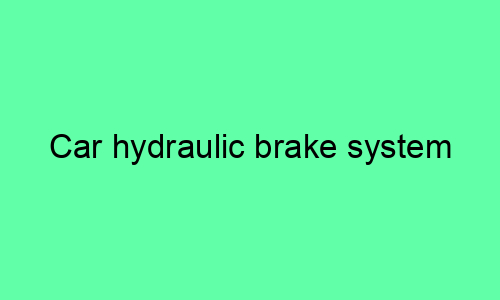Car Hydraulic Brake System
Introduction
A car’s hydraulic brake system is a vital part of the vehicle’s safety features. It uses hydraulic pressure to apply force to the brake pads, which in turn slows down or stops the car. The system is made up of several components, including the brake pedal, master cylinder, brake lines, and brake calipers.
How the Hydraulic Brake System Works
When you step on the brake pedal, it activates the master cylinder. The master cylinder is a piston that pressurizes the brake fluid in the brake lines. The brake fluid then flows through the brake lines to the brake calipers. The brake calipers are located at each wheel and contain pistons that press the brake pads against the brake rotors. This action slows down or stops the car.
Components of the Hydraulic Brake System
The following are the main components of the hydraulic brake system:
* **Brake pedal:** The brake pedal is what you step on to activate the brake system.
* **Master cylinder:** The master cylinder is a piston that pressurizes the brake fluid in the brake lines.
* **Brake lines:** The brake lines are the tubes that carry the brake fluid from the master cylinder to the brake calipers.
* **Brake calipers:** The brake calipers are located at each wheel and contain pistons that press the brake pads against the brake rotors.
* **Brake pads:** The brake pads are the friction material that presses against the brake rotors to slow down or stop the car.
* **Brake rotors:** The brake rotors are the metal discs that the brake pads press against to slow down or stop the car.
Maintenance of the Hydraulic Brake System
The hydraulic brake system is a vital part of your car’s safety features, so it is important to keep it in good working condition. Here are some tips for maintaining the hydraulic brake system:
* **Check the brake fluid level regularly:** The brake fluid level should be checked at least once a month. If the brake fluid level is low, it could indicate a leak in the system.
* **Inspect the brake lines and hoses regularly:** The brake lines and hoses should be inspected for cracks or leaks. If you find any cracks or leaks, they should be replaced immediately.
* **Replace the brake pads when they are worn:** The brake pads should be replaced when they are worn down to a thickness of 1/4 inch or less.
* **Flush the brake fluid every two years:** The brake fluid should be flushed every two years to remove any contaminants that may have accumulated in the system.
Conclusion
The hydraulic brake system is a vital part of your car’s safety features. By following the maintenance tips above, you can help keep your brake system in good working condition and ensure that your car is safe to drive.






